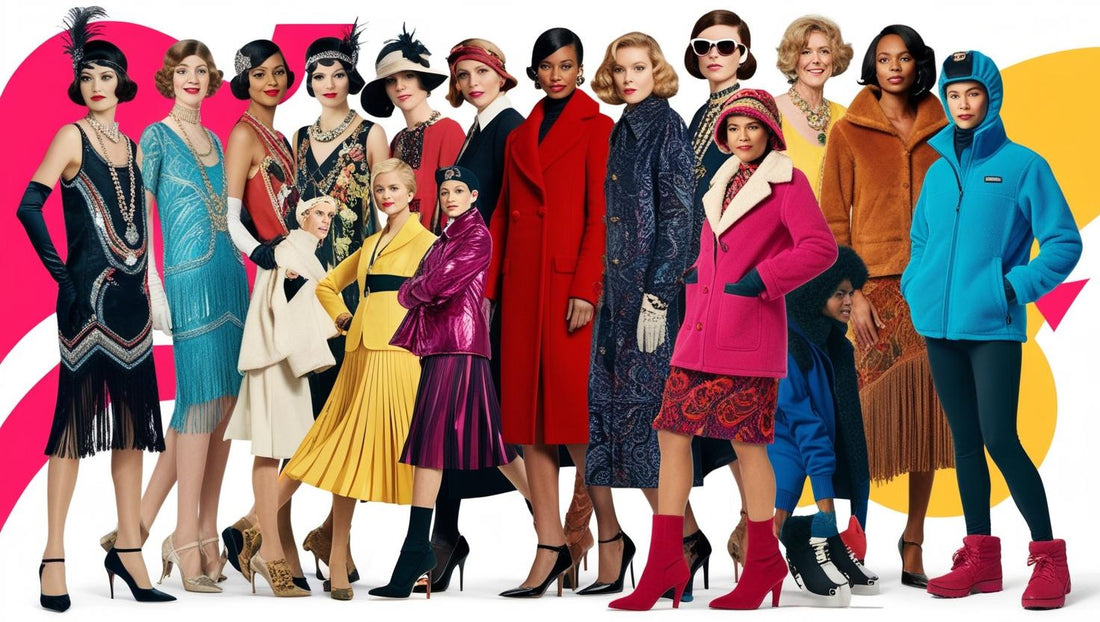
From Flappers to Fleeces: A Whirlwind Tour Through Contemporary Fashion History
Share
Fashion, a mirror reflecting society, has undergone a dramatic transformation in the contemporary era. It's a story of rebellion, liberation, globalization, and constant reinvention. Let's take a whirlwind tour through this fascinating evolution, exploring the key moments and figures that shaped the clothes we wear today.
Post-War Boom and the Rise of Ready-to-Wear (1950s): The 1950s saw a return to femininity after the austerity of World War II. Christian Dior's "New Look," with its cinched waists and full skirts, epitomized this era. However, alongside this elegance, a burgeoning youth culture began to emerge, craving something different. The rise of ready-to-wear clothing democratized fashion, making it accessible to a wider audience.
The Swinging Sixties and Youthquake (1960s): The 1960s were a period of immense social and cultural change, and fashion reflected this upheaval. The "Youthquake" shook the foundations of traditional style, with young designers like Mary Quant introducing miniskirts and other daring designs. Fashion became a tool for self-expression, with diverse styles ranging from mod to hippie. This decade also saw the rise of iconic figures like Twiggy, who embodied the youthful spirit of the era.
Disco Fever and the Me Decade (1970s): The 1970s were a decade of excess and experimentation. Disco culture influenced fashion with its glamorous jumpsuits, platform shoes, and shimmering fabrics. The "Me Decade" also saw the rise of individualistic styles, with influences ranging from punk rock to bohemian chic. Designers like Diane von Furstenberg with her wrap dress, catered to the increasingly independent woman.
Power Dressing and the Rise of the Supermodel (1980s): The 1980s were a decade of power and ambition, and fashion reflected this. "Power dressing" became the norm, with women wearing tailored suits and shoulder pads to assert themselves in the workplace. This decade also saw the rise of the supermodel, with figures like Naomi Campbell and Linda Evangelista becoming global icons. Designers like Yves Saint Laurent with his Le Smoking suit, further blurred gender lines in fashion.
Grunge, Minimalism, and the Dawn of the New Millennium (1990s-2000s): The 1990s saw a reaction against the excesses of the 1980s. Grunge fashion, with its ripped jeans and flannel shirts, became a symbol of anti-establishment sentiment. Minimalism also emerged as a dominant trend, with designers focusing on clean lines and simple silhouettes. The dawn of the new millennium brought with it a renewed focus on individuality and self-expression, with the rise of streetwear and the increasing influence of celebrity culture.
Fast Fashion, Social Media, and the Sustainability Movement (2010s-Present): The 2010s and beyond have been marked by the rise of fast fashion, making trends more accessible than ever before. Social media has played a significant role in shaping fashion trends, with influencers and bloggers becoming powerful forces in the industry. However, the negative environmental and social impacts of fast fashion have led to a growing awareness of sustainability. Consumers are increasingly demanding ethical and eco-friendly options, leading to the rise of sustainable fashion brands and practices. Inclusivity and body positivity have also become important themes, with the fashion industry slowly but surely becoming more diverse and representative.
The Future of Fashion:
Contemporary fashion history is a testament to the ever-evolving nature of style. As we move forward, technology, sustainability, and inclusivity will continue to shape the future of fashion. One thing is certain: fashion will continue to be a powerful form of self-expression, reflecting the changing times and the diverse tapestry of human experience. The story of contemporary fashion is still being written, and it promises to be an exciting journey.
